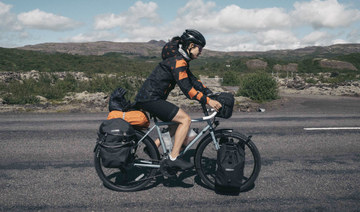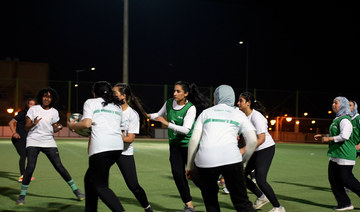JEDDAH: Iranian clerics have outlawed Zumba, a mode of exercise that involves dance and aerobic movements performed to energetic music.
According to a report in The New York Times, Iranians shaking their hips to Latin American music during Zumba exercise classes is sinful.
“Iran has undergone a health revolution in recent years, and as in many countries, Zumba, an aerobics dance class, has attracted a wide following, especially among women who gather a couple of times a week to work out to upbeat tracks by singers like Ricky Martin and Shakira and lose weight in the process,” said the New York Times.
The edict banning the exercise was issued this month by the head of the Sports for All Federation, a government institution promoting sports and a healthy lifestyle. It described Zumba classes as “contrary to Islamic precepts.”
“Since 1979, Iran’s Shiite Muslim clerics have codified into law hundreds of lifestyle regulations, meant to keep their flock on the right path. In their world, things like drinking alcohol, mixing between men and women, and dancing can lead to committing sins. Sins can undermine families, the cornerstone of life in Iran, so it has been decided that these temptations, and many others, are illegal, as an extra push to make sure they do not happen,” said The New York Times.
The head of the Sports for All Federation, Ali Majd Ara, said: “Activities such as Zumba, performance of rhythmic movements and dancing in any form and under any title, lacks legal credibility.”
Iran’s clerics are not the only ones opposing Zumba, said the NYT report. The legal department of Zumba Fitness, the American company behind the fitness craze, revoked permits for those operating in Iran.
Some American companies interpret sanctions on Iran rigidly, and many instructors received a letter saying that only if they moved to a country other than Iran would they get their permits back.
‘Sinful’ Zumba — aerobic exercise to music — banned in Iran
‘Sinful’ Zumba — aerobic exercise to music — banned in Iran
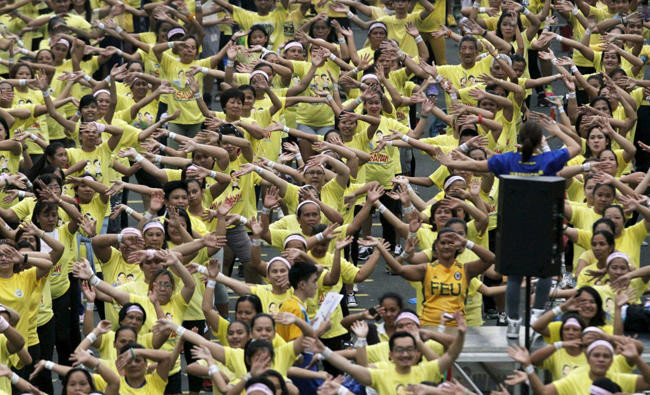
Naomi Campbell sparkles in Nicolas Jebran gown

DUBAI: British supermodel Naomi Campbell wowed fellow guests at the wedding of PrettyLittleThing founder Umar Kamani and model Nada Adelle, which took place at the Hotel du Cap-Eden-Roc in Antibes, France.
Campbell wore a custom couture gown by Lebanese designer Nicolas Jebran, who took to social media to share the supermodel’s ethereal look.
“It is not a catwalk: this is a Naomi-walk with grace & gardens of bliss! The gorgeous beauty queen takes it to the next level! @Naomi, a complete stunner, in a #NicolasJebran custom couture gown as she attended the #kamaniwedding wedding yesterday!” wrote the designer to the stars.
Campbell herself posted three white heart emojis and: “My chosen family! Would not want to be anywhere else than with you on this day, TO WITNESS THIS BEAUTIFUL UNION OF UNCONDITIONAL LOVE MR & MRS KAMANI @nadakamani @umarkamani WE LOVE YOU.”
The wedding was also attended by Saudi Arabia’s Mohammed Al-Turki, the CEO of the Red Sea Film Festival Foundation. Other celebrity guests included former England international footballer Rio Ferdinand, fashion designer Manish Malhotra, singer Christina Milian, and Ronan and Stormy Keating.
Serenading the couple during the wedding ceremony was renowned Italian tenor Andrea Bocelli, who performed his rendition of “The Prayer,” accompanied by a full orchestra, as Adelle walked down the aisle.
Supermodel Campbell enjoys a huge fan base in the Arab world. She has also been romantically involved with individuals from Saudi Arabia, Qatar and Egypt.
Late last year, she was among was among the celebrities spotted on the red carpet at the Middle East and North Africa premiere of “The Absence of Eden,” on the third day of Jeddah’s Red Sea International Film Festival.
“I love what Red Sea has become and that it’s growing and growing and growing. And it’s really amazing and phenomenal what the team and Mo (Al-Turki) and Jomana (Al-Rashid) have created,” said Campbell in a video posted on festival’s Instagram page.
Her charitable organization, Fashion for Relief, also joined forces with Qatar Creates to launch a new global initiative called Emerge. The catwalk star co-hosted a charity gala and fashion show to support creatives and business talents around the world, with a focus on Africa, the diaspora and developing communities.
Meet the Russian stylist living ‘blissfully’ in Saudi Arabia
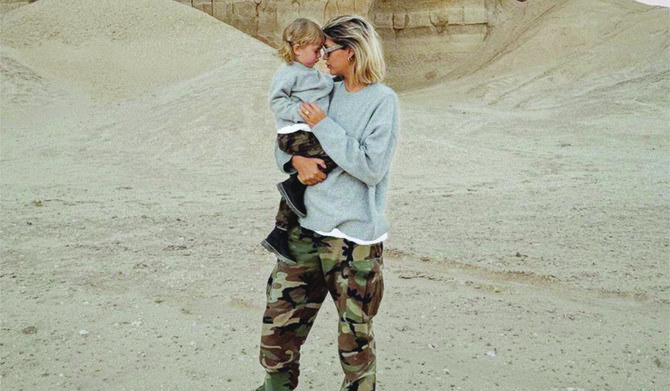
- “True to our expectations, we’ve found immense satisfaction living in Saudi Arabia. We consider it the best decision we’ve made for our family, and have no regrets.” Marsden, a professional stylist, told Arab News
RIYADH: Margo Marsden relocated to Saudi Arabia two years ago when her husband — a British oil and gas engineer — accepted a job in the Kingdom. Since her arrival, she has been documenting her experience of life in Saudi Arabia on social media. Her TikTok profile states she is a “Russian mother married to British father … living blissfully in Saudi Arabia.”
“True to our expectations, we’ve found immense satisfaction living in Saudi Arabia. We consider it the best decision we’ve made for our family, and have no regrets.” Marsden, a professional stylist, told Arab News. “Living here is incredibly invigorating; one can palpably sense the positive transformations taking place in the country, aligned with the ambitious Vision 2030 plan. In my view, Saudi Arabia stands as the premier destination for living in 2024.”
Marsden was born and raised in Kazakhstan before moving to Russia with her parents when she was 14 years old. She lived in several countries before relocating to Saudi Arabia, including Malaysia, Singapore, Italy, Turkiye, Lebanon, Thailand, the UK, and Norway.
Living here is incredibly invigorating; one can palpably sense the positive transformations taking place in the country, aligned with the ambitious Vision 2030 plan.
Margo Marsden, Russian stylist in KSA
Marsden had worked in Riyadh for a month in 2019 with fashion retailer Zara during Ramadan, and when her husband told her about his job offer, she was thrilled at the prospect of visiting the Kingdom again.
“I love it here, and I look forward to sharing my knowledge with local and expat women, to elevate their confidence and refine their fashion identity,” she said.
Marsden now has more than two decades of experience in the fashion industry. It’s a passion that began in her childhood, when she would meticulously craft outfits for her Barbie dolls with her mother’s guidance.
Marsden said she worked as a model — treading catwalks in Russia, Kazakhstan, Hong Kong, Malaysia, Singapore, Sri Lanka, Lebanon, Turkey, Trinidad and Tobago, and Thailand — before moving into the business side of the industry, studying fashion design at Accademia Italiana in Bangkok and personal styling at the London College of Style. She has worked as a buyer, content creator and stylist.
“My artistic pursuits also extend behind the camera; I coordinated photoshoots for both personal and corporate clients,” she added.
As a stylist, she said, her main objective is “to enhance my client’s natural beauty and instill confidence in each customer I work with.” While Marsden doesn’t currently have any clients in the Kingdom, she is hoping to establish her own business eventually.
“I’m eager to offer my expertise to individuals keen on enhancing their appearance. Helping others look and feel their best is immensely fulfilling to me,” she added.
To follow Marsden’s journey in Saudi Arabia, visit her Instagram @margo.marsden.
Simi and Haze Khadra discuss the functional vision of their beauty brand and its Middle East launch
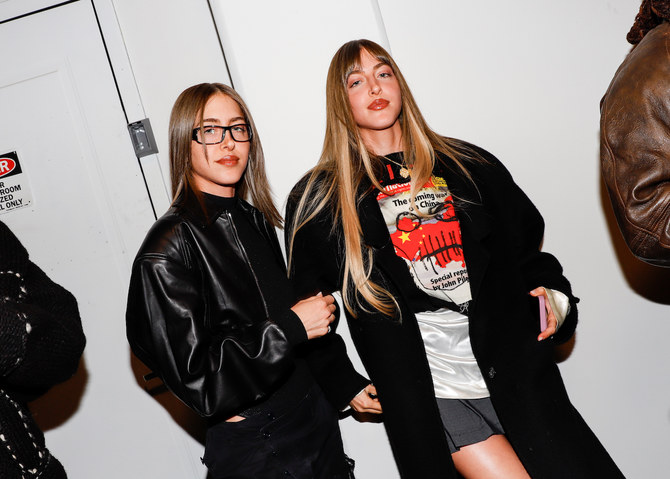
DUBAI: US-Palestinian beauty entrepreneurs Simi and Haze Khadra this week went on tour in the Middle East to launch their brand, SimiHaze Beauty, in the region. Their travels included stops in Saudi Arabia and the UAE.
While in the region, the sister duo — raised by Palestinian parents between Riyadh, London and Dubai — shared insights about their brand with Arab News.
The 31-year-old identical twins, who are also DJs, said that they initially launched the brand out of “pure functionality,” creating products they wanted and needed in their own makeup routines.
Every product they develop undergoes the same rigorous process of ensuring functionality, they said.
“We are constantly thinking of new ideas and ways to make makeup easy and fun to apply,” Simi told Arab News.
The pair launched their US-born cosmetics brand in 2021 with a range of stick-on makeup designs that can be placed on the face for a bold beauty look achievable within seconds.
The sticker book features an array of edgy designs inspired by their favorite DJ looks from the past, such as chrome wings, neon negative space eyeliner and holographic cat-eyes.
SimiHaze Beauty then expanded to include a range of products, such as lipsticks, bronzing powders, and a lifting mascara.
Simi and Haze believe they were “actually late bloomers to the beauty world.”
“We only started becoming interested in it when we were around 18,” Haze said. “We started SHB from just a single product we wanted but couldn’t find in the market, which is our Velvet Blur lipstick.
“We loved a matte lip for every day at the time but couldn’t find one that wasn’t drying, so we created it.”
The twins developed an interest in eye makeup when they began DJ-ing.
“We weren’t the best at applying eyeliner, so again we just created our perfect solution which became the eye stickers,” Haze said.
To the sisters, launching the brand in the Middle East “felt so surreal.”
“The market has been such a huge goal of ours since we started because we grew up here,” Simi said. “We’re so happy that our products are finally accessible to our amazing followers here, because they have been such huge supporters since the beginning.
“Now people are finally able to really see and touch and feel the products, which is so important to us because you will never get the experience and vision of SHB unless you actually hold the product and feel the texture, curves, and ergonomics of it. The online experience doesn’t do it any justice.”
The sisters said that they personally oversee the development of every product. They visit their lab in Italy for a few days at least twice a year to test and create new formulas.
“It takes a while and a lot of back and forth because after we create something it gets tested on our whole family from my grandma to my mom to my little sister and also all my friends with different skin tones,” Simi said.
“My friends are used to me calling them and saying: ‘Hi can I come over and try on some blush colors on you?’ So by the end of it we know what formulas and shades work best on the widest range of people.”
While visiting the Middle East, the sisters observed a prevailing trend in the region: skincare.
“I’ve seen so much good skin here and I can tell people really care about skincare here,” Haze said.
“We’ve also been increasingly obsessed with it. Our products are all infused with skin-loving ingredients, because we’re personally super-paranoid about anything that’s clogging or could cause irritation.”
Loli Bahia, Arab models walk Chanel cruise show in France
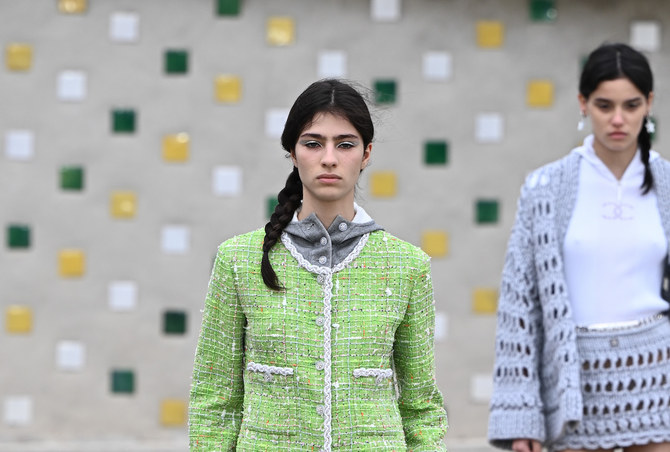
DUBAI: French Algerian model Loli Bahia, British Moroccan Nora Attal, and part-Saudi Amira Al-Zuhair took to the runway at the Chanel Cruise 2024/2025 show in Marseille, France.
Bahia donned a green ensemble, composed of a knee-length pencil skirt paired with a matching top, layered over a white shirt boasting a hoodie collar.
Attal graced the runway in a white summery dress adorned with delicate sheer geometric prints, complemented by white slippers.
Her look also featured beach-inspired layered necklaces, a thin chain belt and chunky bracelets adorned with hat, ship anchors and Chanel logo pendants.
Meanwhile, Al-Zuhair sported a vibrant yellow ensemble featuring hot shorts paired with a button-down top and a coordinating cardigan.
She also wore a beige hat, a gold choker embellished with blue detailing, chunky earrings and a chain belt adorned with pendants.
From intricate embroideries to dazzling sequined jackets and swimwear, Creative Director Virginie Viard’s latest collection showcased ensembles inspired by an underwater reverie.
The outfits included knee-length Bermuda shorts, high-waisted shorts, loose trapeze dresses, and large outerwear. Viard also demonstrated the power of layering, using shirt collars, French cuffs and jackets in unexpected ways throughout the collection.
Earlier this week, Chanel shared a series of images, captured by British photographer Jamie Hawkesworth, on Instagram featuring Bahia. The pictures, drawing inspiration from the seaside and scuba diving, provided an initial preview of Viard’s collection.
Bahia showcased multiple ensembles from the collection in the photographs. In the first shot, she dazzled in a glitzy black sequined mini pencil skirt and blazer. Another image captured her wearing the green ensemble seen on the runway, with the hoodie of the white shirt covering her head.
Additionally, she was photographed donning a white one-piece swimsuit adorned with a black bow around the chest.
The photo series also featured Bahia in a variety of other outfits, including a vibrant white dress with colorful square-like designs, tailored shorts paired with a blazer, as well as a striped set featuring a full-length skirt and matching top.
Moroccan photographer Hassan Hajjaj captures the culture of AlUla

- The acclaimed Moroccan photographer discusses his recent show in Saudi Arabia
DUBAI: Early in February this year, Moroccan contemporary artist and photographer Hassan Hajjaj was given a reminder of just how high his star has risen. Within a few days of each other, Hajjaj had shows opening in the US, Morocco, and — as part of AlUla Arts Festival — Saudi Arabia.
Hajjaj’s playful portraiture, which incorporates vivid color, funky clothing (almost all of which he designs himself), geometric patterns, and — often — vintage brands from the MENA region, has made him internationally popular, and his instantly recognizable style has established him as one of the world’s leading photographers.
His show in AlUla consisted of images that he shot in the ancient oasis town in February 2023. That visit was initially supposed to involve shoots with around 20 local people. It’s the kind of thing he’s done a few times before, including in Oman and Abu Dhabi. “It’s always a good opportunity to get to know the culture and the people,” Hajjaj tells Arab News.
But, as he says himself, he arrived in AlUla as “an outsider,” so needed a team on the ground to persuade locals to come and sit (or stand, in most cases) for him.
“It was a bit tough, in the beginning, for them to find people,” Hajjaj explains. “But because it was during a period when lots of art things were happening in AlUla, there were lots of people coming from outside AlUla as well. So we opened it up. I basically said, ‘Just come.’
“In the end lots of people turned up, not just locals — people from Riyadh, Jeddah, and people (from overseas) too. I think I shot around 100 people over a few days. So it was a great opportunity,” he continues. “To get to shoot that many people over three days — organizing something like that for myself might take a year. So, as long as I have the energy, when I get these opportunities — you know, I’m in AlUla with this eclectic bunch of people — I’d rather go and grind it, really work hard, and have that moment.”
A Hassan Hajjaj shoot isn’t your regular portrait shoot, of course. “It’s almost like a performance,” he says. “There’s music, people dress up, it’s like a day out for them, taking them out of themselves for a few hours.”
He followed the same modus operandi in AlUla. “We got an ambience going. It was fun, there was music… I shot in this beautiful old school that was one of the first girls’ schools in Saudi Arabia, from the Sixties. Upstairs was like a museum — everything was like a standstill from the Seventies and Eighties; even the blackboards had the chalk and the writing from that time,” he says.

A crucial part of Hajjaj’s practice is to ensure that his subjects are at ease and feel some connection with him (“comfortable” is a word he uses several times when talking about his shoots). While all his portraits bear his clearly defined style, it’s important to him that they should also show something unique to the people in them.
“It’s that old thing about capturing the spirit of the person in that split second, you know? I’m trying to get their personality and body language in the image,” he says. “Quite often I’m shooting in the street, outdoors, so (the subjects) can start looking at other people, thinking, ‘Are they looking at me?’ So I usually say, ‘Listen. This is a stage I’m building for you. I’m dressing you up, and we’re going to have fun.’ Then I just try and find that personality that can come out and make the image stronger. With some people, though, saying almost nothing can be better — just getting on with it. I try to kind of go invisible so it’s the camera, not the person, that’s doing the work. The best pictures come out when there’s some kind of comfortable moment between me and the person and the camera.”
It’s the way he’s worked since the beginning — a process that developed organically, as most of his early portraits were of “friends or friends of friends.”

“There’s a comfort in that because you have a relationship with them. It made it easy,” he says. “And that taught me about how important it is to build trust with people to get into that comfortable zone. But as time went on, obviously, people could see the stuff in the press or on social media, so then people started, like, asking to be shot in that manner; maybe they’ve studied the poses of certain people and stuff like that, so they come ready to do some pose they’ve seen in my pictures. That’s quite funny.”
The work that was on display over the past two months in Hajjaj’s “AlUla 1445” is a perfect example of what he tries to achieve with his shoots. The images are vibrant, playful, and soulful, and the subjects run from a local goatherder through the AlUla football team to bona fide superstars: the US singer-songwriter Alicia Keys and her husband Swizz Beatz.
Hajjaj says he has a number of favorites “for different reasons,” including the goatherder.

“He brought in two goats and it became quite abstract when you put all of them together. I was playing with that notion of the person; you could see that’s his life and even the goats look happy,” he explains. “I wanted to make sure they had that shine in the image as well. I got some great shots of him.”
The Alicia Keys and Swizz Beatz shoot has been a long time in the making. Hajjaj first met Swizz Beatz a decade ago, and they have been in touch intermittently ever since. The idea of a shoot with Keys first came up about five years ago, but logistics had always got in the way. But since they were playing a concert in AlUla at the same time as Hajjaj was there, it finally happened, on Hajjaj’s last day, with perhaps an hour left before the light faded.
I ask Hajjaj if his approach to shooting celebrities differs from his shots of “ordinary” people.

“There’s probably not that much difference,” he says. “They’re coming into my world, so, again, it’s just making sure they’re comfortable with you and you’re comfortable with them; not looking at them (as celebrities). The only thing is you have to imagine they’ve been shot thousands of times — by top photographers, too — so they’re going to have their ways. So I just have to lock in with them and find that comfortable space between the sitter and me.”
And then there’s Ghadi Al-Sharif.
“It’s a beautiful picture. She’s got this smile, with her hand over her face. For me, that one really presents the light and the energy of AlUla,” Hajjaj says. “It captures the new generation.”


